One of the issues with the maturity models we often use to assess teams is they are context free. They don’t take the environment into account, missing the challenges and the specific needs we have in our context. We will explore an alternative: Maturity Mapping. How can Wardley Mapping, Social Practice Theory and Cynefin be applied together to develop situational awareness and build a shared understanding of the practices you use and the unique challenges you face.
Summarising Twitter thread about the talk by Sara Dufour (@ComSaraDufour)
LT;DR Maturity Mapping
Child of Chris McDermott (@chrisvmcd)
- starting point: focus on practices to understand organisations from the perspective of what people do instead of who their are
- then Jabe Bloom (@cyetain) started talking about Social Practice Theory as a method of analysis
- Maturity Mapping is a way on how to map practices and how they connect
- Maturity Mapping as an emergent method to visualize capabilities described as a group of integrated practices to discuss interventions is socio-technical systems
Chris (@chrisvmcd send me this map, a Wardley Map.
See “Situation Normal, Everything Must Change” from Simon Wardley (@swardley) later in this conference.
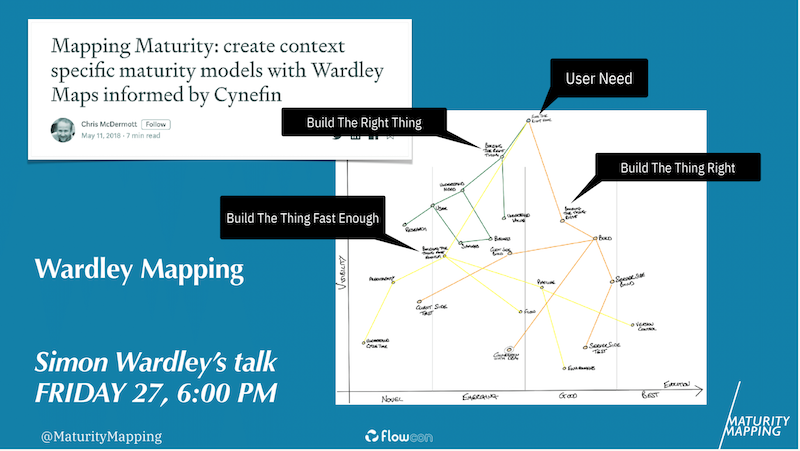
A Wardley Map has an Evolution (X-axis) at the bottom: how you get good at what you are already doing
Wardley Map: Genesis - Custom Built - Product (+rental) - Commodity (+utility)
Maturity Mapping: Novel - Emerging - Good - Best
The important bit is at the bottom: evolution on how you get better at a practice as you go from left to right
Visibility (Y-axis): in a Wardley Map that is the user need
We will talk about capabilities, organisation or capability needs, what work needs to be done
What motivated us to go down this road?
Traditional View (in the Western world): see the world as machines
=> everything we describe in an organisation, the way we model, describe (org charts, …) all use the machine metaphor
but living beings are not a machine
Russel Ackoff:
- organicity of Wholes
- interdependency of parts
- emergence of attributes none of the parts have through interactions
parts are interdependent
therefore, the system as a whole can not be divided into independent parts
=> the essential attributes of a system as a whole which none of its parts have
ex: automobile: essential attribute is to get you from one place to another, none of the parts can do this, the wheels can’t, the seats can’t, … the automobile can
you live, none of the parts of you live, you have life
you can write, your hand can’t write
you can see, your eyes can’t see
you can think, your body can’t think
and therefore if the system is taken apart it looses its substantial properties
if I bring an automobile into this room and disassemble it, I don’t have an automobile
because a system is not the sum of the behaviour of its parts, its a product of their interactions
– Russel Ackoff
Core of its message is:
interactions are creating properties out of the parts the parts themselves don’t have
we call this: they emerge => there is a new whole that emerges out of these properties
this is what creates meaning
Meaning exists in the interactions between things, not in the things themselves.
– Alicia Juarrero (Complexity Philosopher)
So having a list of your practices is not useful
Because the meaning of the practices come from the interactions the various practices have in your environment with your people as well as with your technology
How good an organisation does human nature permit?
vs
How good a human nature does an organisation permit?
– Abraham Maslow
(and no he never created and endorsed the pyramid - it was a fake from a management consultant)
Apparently Maslow never designed any pyramid 🤯
You’ll come across so many unexpected stuff at #flowcon… :)
– Sara Dufour (@ComSaraDufour), Nov 5, 2020
We always operate at two levels:
- the organisation itself, limits what we can do as individuals
- but the organisation is also limited by what we can do as individuals independent of the organisation
=> we need to interact at both levels
sometimes constrain things from the organisational level to enable us to do something as individuals
sometimes as individuals constrain what we make available for the organisation so that the organisation can gain greater capability
An introduction to Social Practice Theory
Instead of focussing on #psychology, trying to understand semiotics, behaviour, interactions, influence.
#Systems analysis at #Flowcon with @somesheep
– Sara Dufour (@ComSaraDufour), Nov 5, 2020
It is important to shift the focus from individuals (psychology) to practices (social)
Let’s stop using psychology and yet use social phenomena (and hence social practice theory)
Social Practice Theory has its roots in …
Pierre Bourdieu
- symbolic & social capital
- habitus
- fields
- …
Work as social activity
– Pierre Bourdieu
see “La théorie sociale de Bourdieu adaptée à la tech” by Romeu Moura (@malk_zameth) later in this conference
Bourdieu tries to understand society from perspective of the social interaction.
Everybody would know what we would do with normal capital, i.e. financial.
But much more important are symbolic and social capital. Also because they exist in societies that do not have currencies.
Social capital = relationships, people you know, you get access to better jobs if you know somebody with influence, the value we are getting from having relations with other people
Symbolic capital = more cultural, it is more culture specific, eg I have a big diamond on the ring at my finger, it shows I am rich, it shows I’ve achieved something and so you give me respect, it is not so important whether the diamond was expensive as what it symbolises
Habitus = a field of habits, or practices, that is how we exist, how we interact in our environment
Remember Maslow: society influences us or limits us or enables us, but equally we enable society or we limit society this interaction can be seen as Habitus
Bruno Latour
- from inspecting the Being (psychology) to inspecting the Doing (interactions, social)
- Performed & Shared
- “Work as site of practice”
- Worker as Practitioners
He wanted to get away from inspection of being and instead inspect the doing
He started to articulate what is now seen as Social Practice Theory
practices are performed but also they are shared, the way you learn a practice is someone shows you, sometimes you can learn from books or youtube video’s, but what you are and the way you are doing in an organisation is “you are a practitioner”
If we want to look at practitioners, how would we start describing practices in a tangible way?
Chris McDermott (@chrisvmcd): show me all the things that you are doing: teams show Jira, or frameworks they use, … => very confused
Almost everything you do can be described as a practice: from the morning you get up, you wash yourself, you have breakfast, you do some work …
We were looking for a language:
how can we express practices in a tangible way also in a way we can talk to each other about practices in a meaningful way like how can we improve a practice
Maturity Models
Some things need to be said …
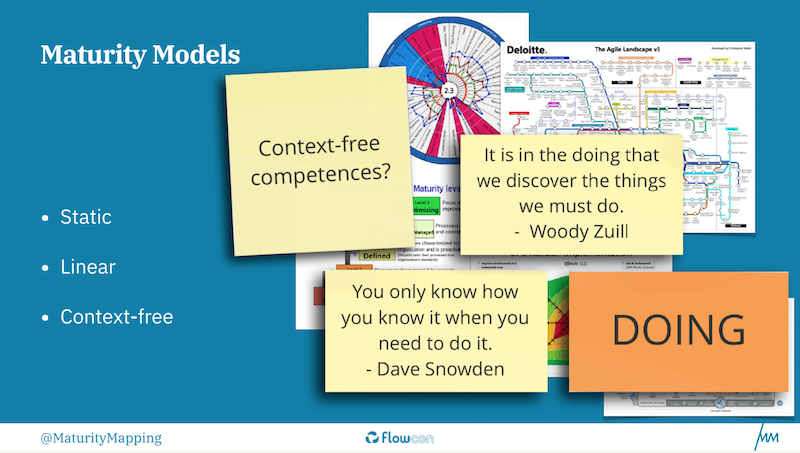
Best practices?? a practice might be good in one environment but it is not always best in any other environment or in any circumstances
yet Maturity Models have this need to express things in universally valid circumstances and framings
usually practices encapsulate some value of things that were learned by the people who did it, so they are practitioners
but, the biggest problems with Maturity Models:
- static
- linear
- context-free
they don’t change, they don’t adapt to your context
=> Maturity Models see competences as something that is context-free. This fundamentally disagrees with what Bourdieu and Latour say about practices.
Practices happening in certain environments are an expression of characteristics of the environment, the people and the technology that we are using in this environment.
You can’t take competences out of context. (and copy them to other teams or other organisations)
you only know how you know it when you need to know it
– Dave Snowden (@snowded)
Even when you try to explain something to somebody how they need to do something, you will miss things, you won’t even be aware
The easiest way to teach somebody a practice is pairing. You have to be in the context, with the people, with the technology doing it to properly explain the practice.
It is in the doing that we discover the things we must do.
– Woody Zuill (@WoodyZuill)
Unless we do the practice we will not discover what we actually should be practising.
You can start with a practice. But as soon as you start practising, you will start experiencing friction. Friction informs you how you have to change the practice to your context.
Unless you do, you will not have any experiences from your context that informs you how you improve.
The problem with most maturity models…
“You can’t pretend to understand and analyse competences if out of context! It’s all about DOING.” @somesheep #flowcon
– – Sara Dufour (@ComSaraDufour), Nov 5, 2020
So: all about doing!
To conclude there is a problem with the word Maturity Models:
if you don’t do things this way you are not mature.
What works for a ‘mature’ multinational is going to be counter productive for an ‘immature’ 30 person company
– Adrian Howard (@adrianh)
What we often experience though when applying maturity models, is that: we don’t really do what it says because in our circumstances this won’t work and so we changed it, but now the model says we are immature
=> if somebody comes from the outside and assesses us: we are an immature team
Conflates level of effectiveness with learning path
– Jason Yip (@jchyip)
It conflates effectiveness with learning path.
What you start to realise: It is not very effective to gain expertise in the linear path.
On the path you need to learn what they think fills up their maturity but a lot of that might be irrelevant for the problem you are trying to solve.
So you will start pick and choose from the maturity model according to the problem you are trying to solve. And you might not ever touch the other things if you got the benefit from studying the maturity model
A treasure map where X marks the spot, but no info on the terrain
– Trent Hone (@honer_cut)
It shows you the territory and marks the X and a little path, but it doesn’t tell you anything about topography, obstacles you might encounter.
The worst thing about Maturity Models:
They come with a cast of High Priests: certification programs (like Scrum, SAFe, a whole pyramid scheme of certifications and courses). And then you end but needing people that do the ceremonies as does everybody else otherwise you are not profiting from having invested into this pyramid.
Another way of looking at Maturity Models:
- Decontextualised Experience: they encapsulate experience but it is decontextualised, context is removed
- You as a practitioner need to Re-contextualisation: in the form of customisation, we would say: DORA is a good customisation of good DevOps practices
- Skill of contextualisation > expertise of the model
=> Practice and Capability need Tailoring not customisation
DORA, the questionnaire, is a decision tree => customisation
These are just basic tools. You need to customize models —or frameworks— based on the context.
“Practice & Capability need Tailoring.”
The tailor not only gets your measurements, but also asks why you have X needs, how you’re gonna use the clothes, what’s your daily life like… – Sara Dufour (@ComSaraDufour), Nov 5, 2020
How do you tailor?
How do you recontextualise a maturity model?
Playing in the semantic space and provide an antidote against being judged on the scale of context-free maturity models => why we called it Maturity Mapping
Maturity Model = just a categorisation system
Maturity Mapping = rich content
Jabe Bloom
- Organisations as Open Socio-Technical Systems
- Social interactions mediated by technology
see “Turbulence: Thinking Flow Again” by Jabe Bloom (@cyetain)
Maturity Models play in the space of cognitive engineering.
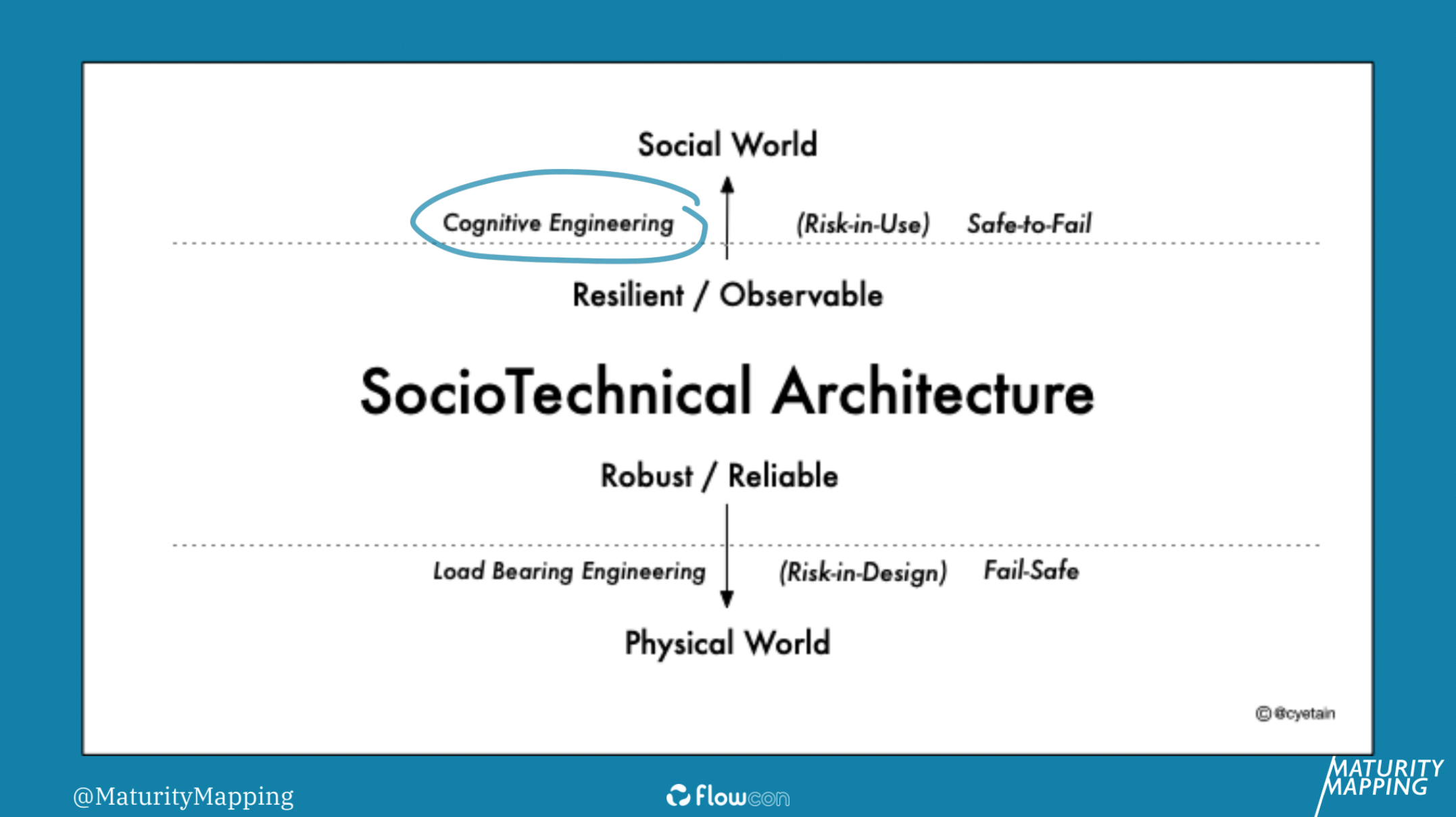
Let’s take baby steps and think Transition instead of #Transformation. #flowcon
– Sara Dufour (@ComSaraDufour) Nov 5, 2020
stop to think about transformation: it has an end-point and it finishes
=> we need to start thinking about transitioning
=> focus on understand the current situation, where we are
Social Practice Theory
Elizabeth Shove
…bearing in mind Elizabeth Shove’s Social Practice Theory, in which Practice is seen as:
— a unit of analysis of socio-technical systems — an integration of meaning+material+competence — that changes/evolves and materializes
#flowcon #Praxis
– Sara Dufour (@ComSaraDufour) Nov 5, 2020
Integration: they are not independent elements, but they interact all the time
important to see: you can improve them all, but you can only do one of them so much until it starts to influence the others
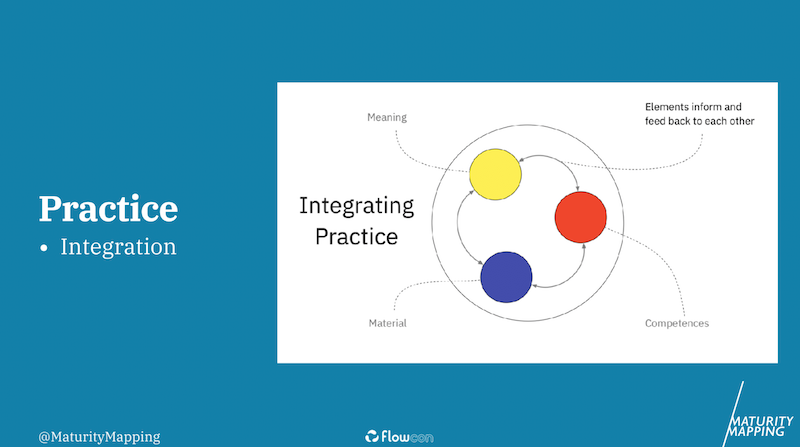
Evolution: it only has 3 stages:
- proto-practices: where you see there is no integration, the things are around but we haven’t seen the integration
- practices: you integrated them and that’s when it becomes a practice
- ex-practices: it might get superseded by another practice that comes along
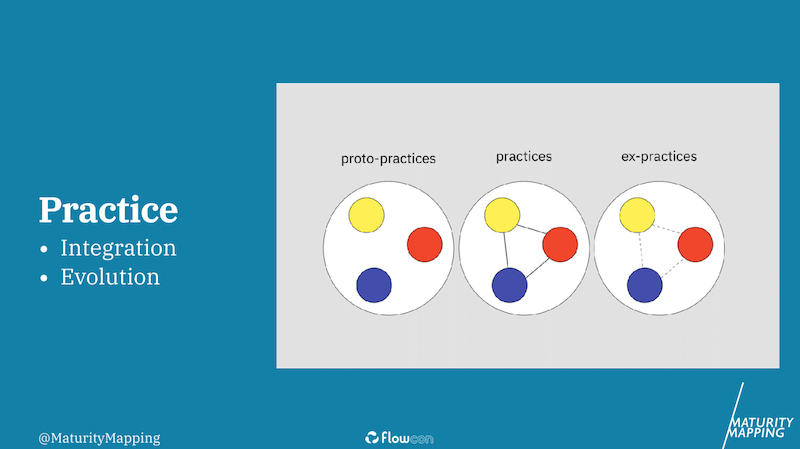
Changes over time: practices evolve over time and they might influence each other
=> practices evolve at different speeds, meaning changes slowly or not
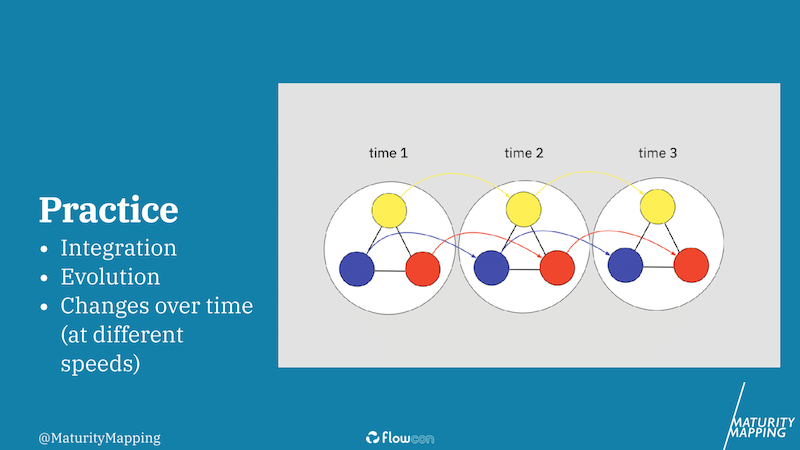
Materialises:
- competence gets materialised, tools are materialised practice
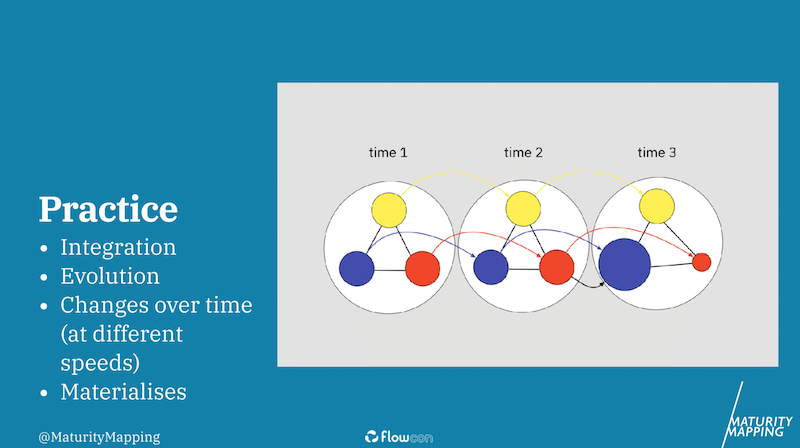
Capability
practice as unit of analysis of socio-technical systems
practice as integration of:
- meaning
- material
- competence
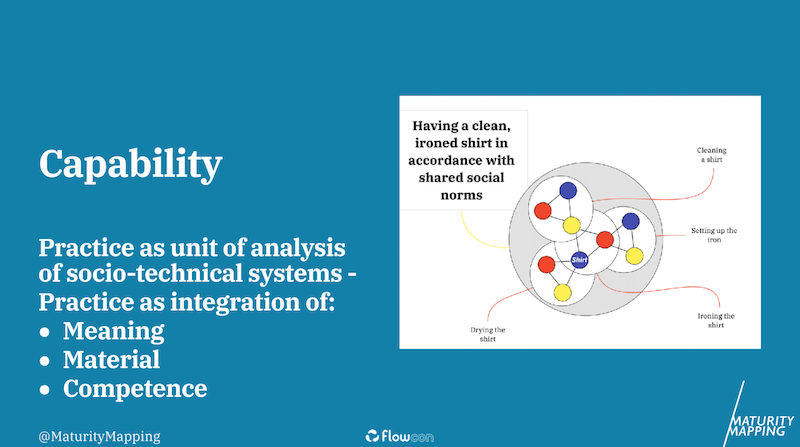
Chris McDermott (@chrisvmcd) on why we like Social Practice Theory
- understand Work
- Why | How | What
- how small Doings integrate together into larger complex Doings
- Social, how we do things together, and Individual, how you and I do things
- how all this information helps to make sense of the context
Maturity Mapping
@MaturityMapping visualizes capability as an evolving and contextualized integration of practices.
You get value from nurturing the practice.
#flowcon #HR #development #skills
– Sara Dufour (@ComSaraDufour) Nov 5, 2020
visualisation of capabilities as an integration of practices that informs us about how we improve
this is a Wardley Mapping
2 axes:
- Left (Y-axis): visibility, at the top the need we want to achieve
- Bottom (X-axis): how good are we - Concept, Novel, Good, Best
it talks about movement
Movement Patterns
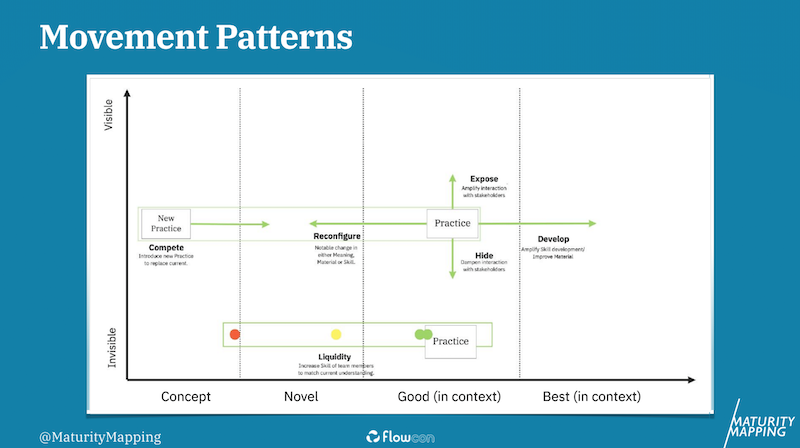
- share the practice => top of the map
- or you want to hide it, stakeholders don’t care about this => put it down at the bottom of the map
going to the right: you want to develop, amplify, scale
going to the left: something is not right, you need to reconfigure (do things again manual, instead of using a tool)
Purpose: why are you doing the map, who are the persons that actually care about the map, actually explain what the need is
Map: describe all the things you do, all the practices
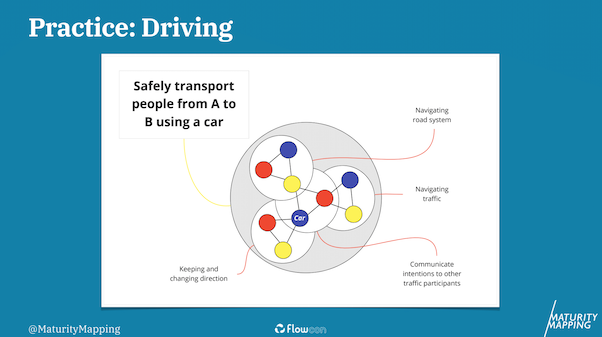 |
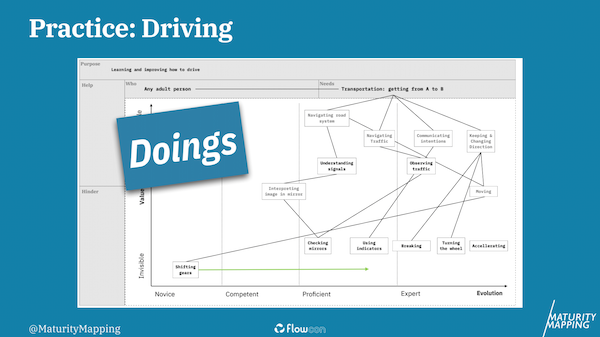 |
The X-Axis
Wardley’s Capital
the core value of a Wardley Map: you get more value from the thing when you go from left to right
- proto-practice: at the beginning
- practice: all the way to the right
- ex-practice: is off the map
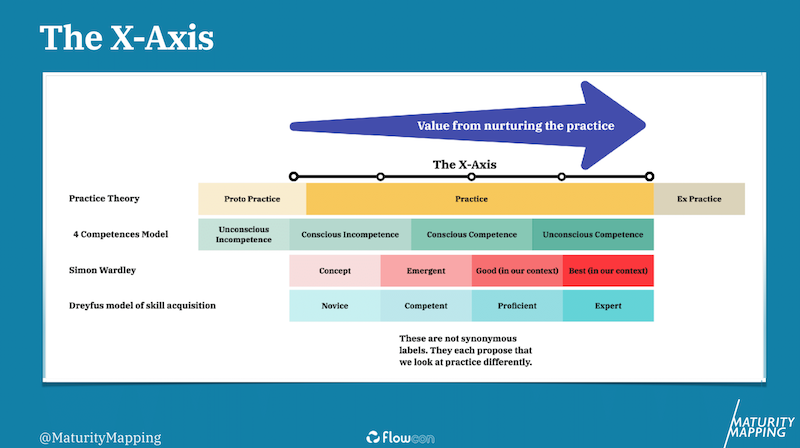
4-competences model:
- unconscious competence: is off the map, if you don’t have sense of the value, you would not even enter the map, you would not know how to improve the competence
- you need to be conscious competence
Wardley has some labels: Genesis - Custom Built - Product (+rental) - Commodity (+utility)
we used: Concept, Novel, Good, Best
this is Work in Process: maybe some day we will come up with better labels
X-Axis Cheat Sheet for Positioning
| Stages of practice | Stage 1 | Stage 2 | Stage 3 | Stage 4 |
|---|---|---|---|---|
| Organisation/Team Discovery | Concept | Novel | Good | Best |
| Individual Learning | Novice | Competent | Proficient | Expert |
| Knowledge | This is new | Think I/we know how to do it | I/we are confident I/we know how to do it | It comes naturally |
| Use | Wouldn’t do it on my own | Used but needs a lot of improvement | Room for improvement | No obvious improvement required |
| Variation | High: do it differently each time but we see similarity | High: only certain elements are repeatable | Medium: do it roughly the same way each time | Low: do it exactly the same way each time |
comes from Observability: what can you observe?
Concept: at the conscious stage: you are aware, you know there is such a thing as a practice or there should be a practice for a particular problem, but you are not really getting any value out of it, you are experimenting things, you want to get used to it
Emerging: start using it to get benefit from it, the organisation can see that you have improved, the value and the benefits are recognised, there is no consistency, that is when you get Good
Good: consistency, now you do some things repeatedly, they work reliably, they give you the value, you still see a lot of friction that is why you are not Best yet, but also your organisation gets interested in this, show us what you are doing, should other people maybe start doing this, now it gets traction, it becomes a thing in the organisation
Best: when the other teams come to ask: please show us, we want to learn from you, we have these problems, can we please discuss these with you, the practice itself is consist, it has no friction, in a retro it never comes up as a thing you need to talk about
The idea is you start with these generic questions.
Over time, add/replace these generic questions by practice specific questions appropriate to your context
As you start using the generic questions, you should be able to say over time: with our teams, in our context, if you still have these problems, you are in Emergent, if you have these kind of problems, you are still in Good or if we see all of these things, then you are in Best.
It is important that you contextualise your X-axis and how you position this in your context. Not a Maturity Model. This is still context-free but it forces you to observe. And so it helps you to contextualise.
Practice Cards
I loved the Practice Cards, and the idea of mapping them.
Here, we can visualize the complexity of an apparently trivial practice, such as ironing a shirt.
– Sara Dufour (@ComSaraDufour) Nov 5, 2020
one card per practice:
- Meaning
- Competence
- Material
and then you can put them on a map
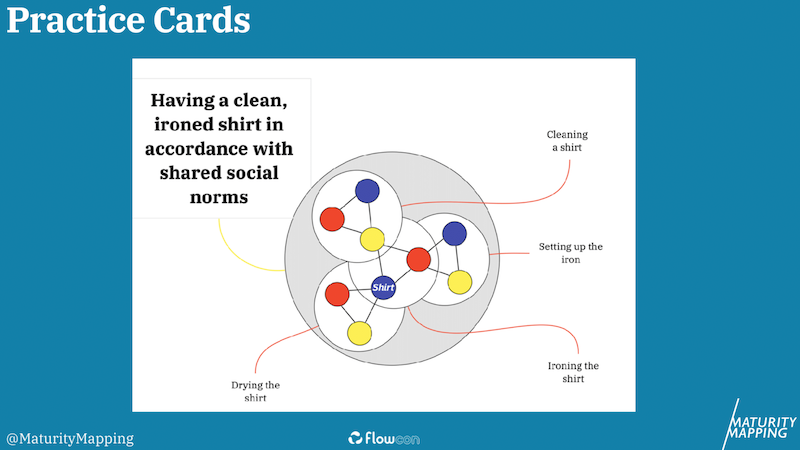 |
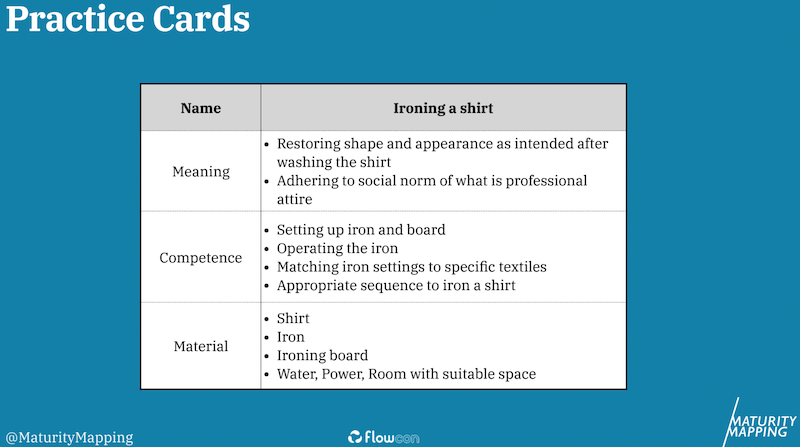 |
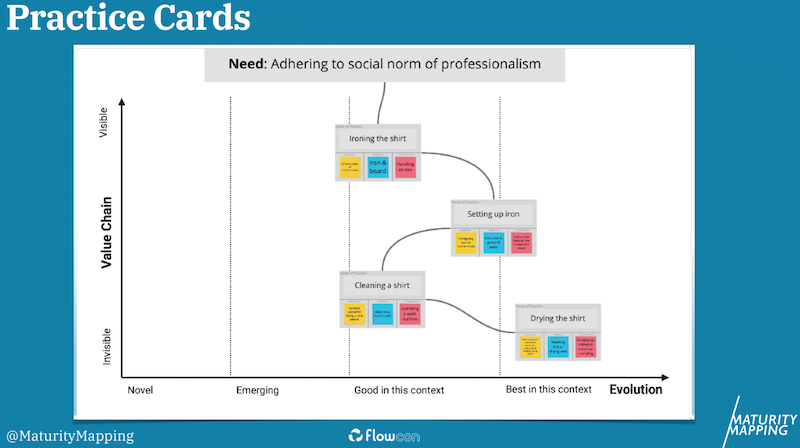 |
Competences are often a bit tricky. What good competences look like?
Capture stories about practices. How you talk about practices?
=> Telling transition stories using maps
Maturity Mapping can also be applied to an individual in a team.
X-axis is evaluated against the team:
- Best is you are the best in the team
- Concept you just know about it but you don’t have expertise about it
=> you can develop personal development maps and you can discuss how this would fit in the bigger picture of the team
Maturity Mapping for skills liquidity:
capture of practices inside a team: for every individual put dots where you have expertise
=> allows to decide on how to best split a team in order to grow
Scale function (the doing) over structure (the being)
“Don’t design a future structure (=being).
Scale function instead (=doing).”
– Sara Dufour (@ComSaraDufour) Nov 5, 2020
When we design things. Don’t design a future structure!
Look at what you’re doing, which of these things that you are doing you want more of (function) what it does (capability) and try to figure out how you get more of that, more people doing it.
How would you embed this? Look at the map. How do these things fit in the wider organisation?
eg You want to have Continuous Delivery. Because you want to release more quickly. But your product function can’t keep up with telling you the good things to build. You are wasting your time improving your Continuous Delivery further. A practice map will start to show the connection between practices: I can’t move this one to the right if the other one is still at the far left. I would not get any benefit. That’s a sign for friction.
This allows you to start focussing on function and let structure emerge.
This is how nature works. Nature never designs structure. Structure is the outcome of evolution.
If you do moves on the practice map, you can use the 4 corners of contextualisation from Cynefin to inform how to do the move.
-
things are clear, everybody knows how to do it
-
complicated: experts know how to deal with it, you want to learn it, but you know who knows it.
-
complex: but a lot of you need to know in an organisation is actually new learning, we need to discover things, they might work elsewhere but the way they work elsewhere does not really translate here, that also is discovering new ways of doing => safe to fail parallel experiments
=> try to find the smallest intervention that could possibly give you benefit
=> try to articulate your transition as the smallest thing that could possibly work
Benefits of focusing on Practices
- Removes the dichotomy of Social vs Technical -> Holistic
- Moves the practitioners and their interactions into the centre of attention
-
Practices are performed - Maturity is defined as:
How well can we perform this practice in our current context
-
Eliminates the illusion that you can plonk any technology into your environment by asking:
- is the meaning of using the new technology coherent with our strategy?
- do we have the required competences to make use of the technology or how can we acquire them?
To Close
Difference between Maturity Maps and Wardley Map
Wardley Map -> articulate your technology, product or service strategy
Maturity Map -> how will you execute it, do we have the right competences, the right skills, are we set up for this or vice versa, what strategy options do we have, where are our strengths, how can we leverage our strength, which practices do we have to improve our strength
Situational awareness of what you do and need to do
Where Wardley is more: where are you in terms of what you have and what you want
The future is not created, it is co-created
– Nilofer Merchant, 2009
The future is not created by a single person.
Future emerges from the interactions, from us trying to improve, to do things better.